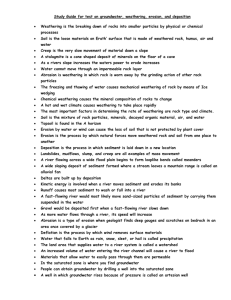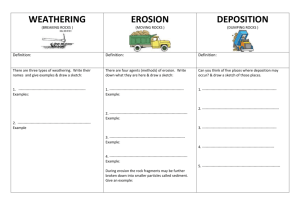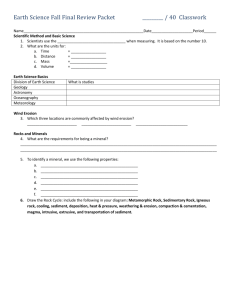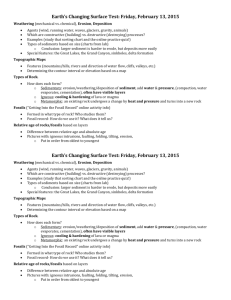Unit 9 Reading _ vocabulary
advertisement
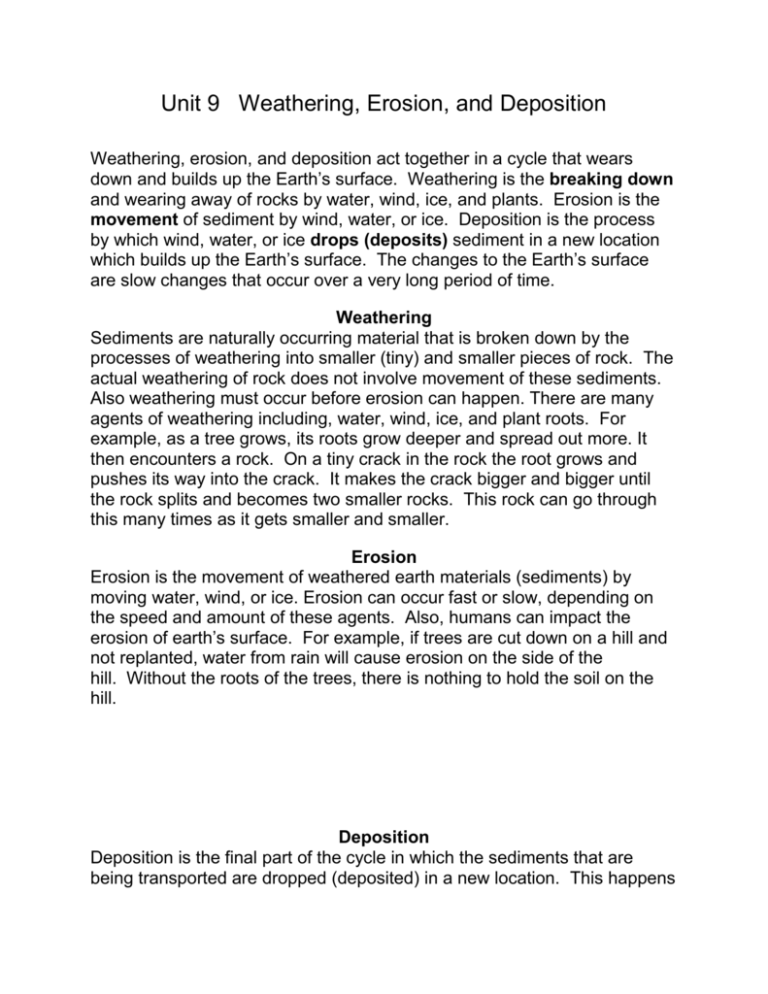
Unit 9 Weathering, Erosion, and Deposition Weathering, erosion, and deposition act together in a cycle that wears down and builds up the Earth’s surface. Weathering is the breaking down and wearing away of rocks by water, wind, ice, and plants. Erosion is the movement of sediment by wind, water, or ice. Deposition is the process by which wind, water, or ice drops (deposits) sediment in a new location which builds up the Earth’s surface. The changes to the Earth’s surface are slow changes that occur over a very long period of time. Weathering Sediments are naturally occurring material that is broken down by the processes of weathering into smaller (tiny) and smaller pieces of rock. The actual weathering of rock does not involve movement of these sediments. Also weathering must occur before erosion can happen. There are many agents of weathering including, water, wind, ice, and plant roots. For example, as a tree grows, its roots grow deeper and spread out more. It then encounters a rock. On a tiny crack in the rock the root grows and pushes its way into the crack. It makes the crack bigger and bigger until the rock splits and becomes two smaller rocks. This rock can go through this many times as it gets smaller and smaller. Erosion Erosion is the movement of weathered earth materials (sediments) by moving water, wind, or ice. Erosion can occur fast or slow, depending on the speed and amount of these agents. Also, humans can impact the erosion of earth’s surface. For example, if trees are cut down on a hill and not replanted, water from rain will cause erosion on the side of the hill. Without the roots of the trees, there is nothing to hold the soil on the hill. Deposition Deposition is the final part of the cycle in which the sediments that are being transported are dropped (deposited) in a new location. This happens when the agent (wind, water, ice) no longer has the ability to move the sediment. For example, a river may be fast moving and narrow, but then widens out and become slower, which then deposits sediments that are too heavy for the slower moving water to keep pushing. Agents of Weathering, Erosion, and Deposition Wind Changes to earth’s surface can be caused by wind. Wind can erode, transport, or deposit fine particles of sediment in areas where there is little vegetation to hold the sediment together. When wind blows particles of sand or other sediment against larger rocks, it scours them. Over a long period of time this will cause the wearing away of these larger rocks. The wind can also transport sediments through the air. How far the sediments travel will depend on the strength of the wind, how long it blows, and what type of vegetation is around. Once the wind dies down or if vegetation stops or slows the wind, the particles of sediment will begin to drop. Water Another agent that can erode, transport, or deposit sediment is water. Flowing water is a major agent of erosion. As water flows, it carries sediment and pieces of rock. These particles rub against other rocks, changing their shapes. Eventually, the sediment and rock are deposited as the water slows. Faster moving water causes more weathering and erosion than slower moving water. A canyon is a valley with very steep sides that usually has been carved by a fast-flowing river. Gravity causes rivers to flow from a higher elevation to a lower elevation. The larger the difference in elevations, the more energy the river expends on its journey. This energy of moving water carves through the weaker rock to form a canyon. Deltas are formed when a river carrying sediment reaches a lake, reservoir, or ocean and the velocity of the water is slowed. The slower water carries less sediment and the larger particles start to fall to the bottom. The smaller particles are carried further into the body of standing water. This deposition forms the delta. Water also changes the Earth by creating caves. Dissolved minerals in water seep into the ground, causing natural hollows to form. Dripping water in caves creates interesting formations, such as stalactites and stalagmites. Ice Ice is the last major agent of weathering, erosion, and deposition. Water often seeps into the cracks in rocks. When the temperature drops, the water in the cracks freeze and expand, causing the crack to widen. Eventually, the rock is broken into smaller pieces. Glaciers are large, flowing rivers of ice that carve U-shaped valleys. As they move inch by inch they push many large particles, rocks, and even mountains out of their way. When these glaciers retreat, they deposit these same rocks and sediment that have been carried by the glacier. Meltwater from these glaciers often form lakes. Unit 9 Vocabulary canyon - a valley between steep cliff sides formed by running water, such as a river or stream cave - a natural, hollow, underground space delta - soil which is deposited at the mouth or a river, usually in a triangular shape deposition - a process by which wind or water drop sediment in a new location erosion - the movement of sediment by wind, water, or ice formation - the way something is structured or created glacier - a large mass of slowly moving ice and snow that carves new features and deposits sediments landform - a physical feature on Earth's surface sand dune - a hill of sand created by the wind stalactite - a cave formation which grows downward from the ceiling, created by mineral deposits from dripping water stalagmite - a cave formation which grows upward from the ground, created by mineral deposits from dripping water valley - low lying land between mountains weathering - the breaking down and wearing away of rocks by water, wind, and ice



